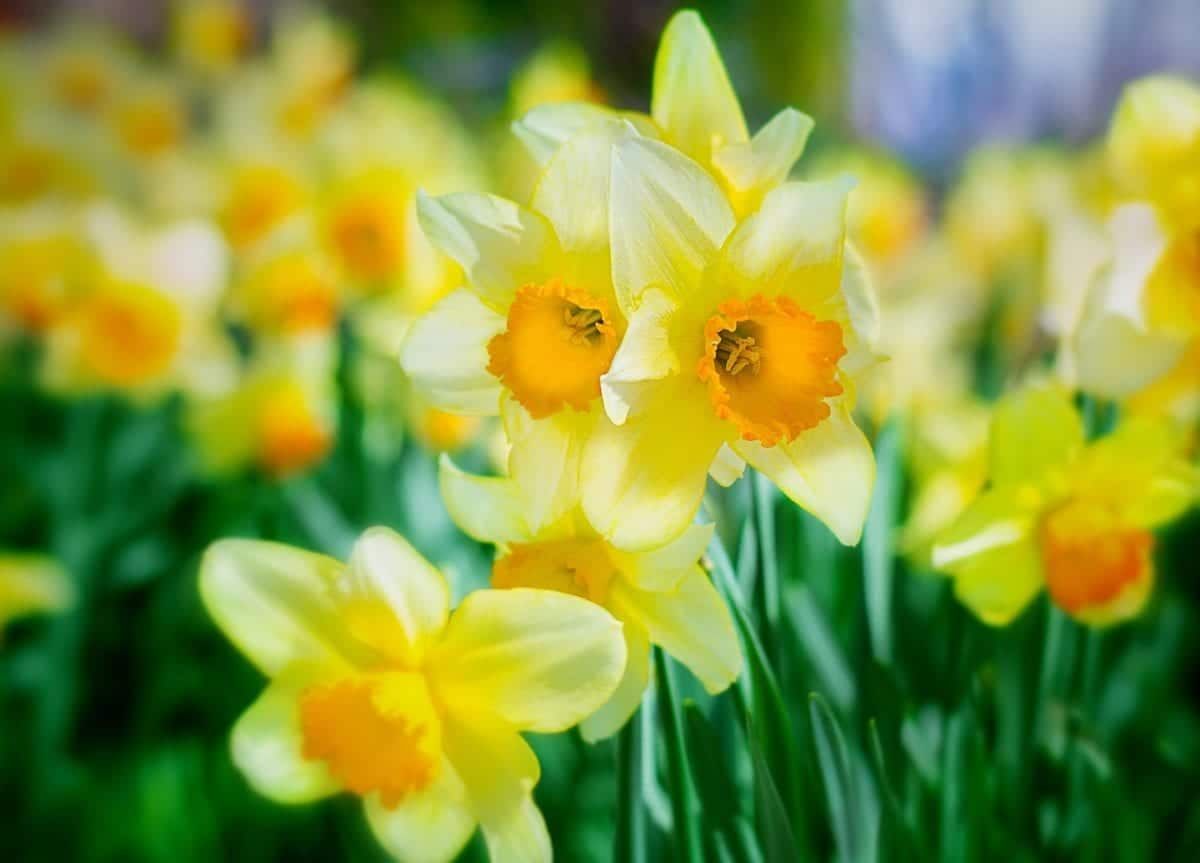There’s a term in Japanese and they say, like unique words in every language I suppose, that it can’t be translated. Wab-sabi. It’s not just a word but a philosophy, a way of life. Loosely interpreted, it means to find beauty in the imperfections of life and gracefully flowing with the natural cycle of evolving and ageing.
But what does it take to live a graceful life where you are not just graceful but grateful and peaceful as well?
In my humble opinion, it requires absorbing a certain quality in your life, in your daily routine, so that it becomes your second nature. No, it’s not compassion, gratitude, forgiveness or some of the other difficult stuff I keep talking about. This particular quality is just about you. You, your life, your world. Before I say it out loud, let me share with you a beautiful little story [set in 1998] I read in Celebration! by Jaroldeen Edwards. Quoting literatim:
Several times my daughter had telephoned to say, “Mother, you must come see the daffodils before they are over.”
I wanted to go, but it was a two-hour drive from Laguna to Lake Arrowhead. “I will come next Tuesday,” I promised, a little reluctantly, on her third call.
Next Tuesday dawned cold and rainy. Still, I had promised, and so I drove there. When I finally walked into Carolyn’s house and hugged and greeted my grandchildren, I said, “Forget the daffodils, Carolyn! The road is invisible in the clouds and fog, and there is nothing in the world except you and these children that I want to see bad enough to drive another inch!”
My daughter smiled calmly and said, “We drive in this all the time, Mother.”
“Well, you won’t get me back on the road until it clears, and then I’m heading for home!” I assured her.“I was hoping you’d take me over to the garage to pick up my car.”
“How far will we have to drive?”
“Just a few blocks,” Carolyn said. “I’ll drive. I’m used to this.”
After several minutes, I had to ask, “Where are we going? This isn’t the way to the garage!”
“We’re going to my garage the long way,” Carolyn smiled, “by way of the daffodils.” “Carolyn,” I said sternly, “please turn around.”
“It’s all right, Mother, I promise. You will never forgive yourself if you miss this experience.”After about twenty minutes, we turned onto a small gravel road and I saw a small church. On the far side of the church, I saw a hand-lettered sign that read, “Daffodil Garden.” We got out of the car and each took a child’s hand, and I followed Carolyn down the path. Then, we turned a corner of the path, and I looked up and gasped.
Before me lay the most glorious sight, it looked as though someone had taken a great vat of gold and poured it down over the mountain peak and slopes. The flowers were planted in majestic, swirling patterns-great ribbons and swaths of deep orange, white, lemon, yellow, salmon pink, saffron, and butter yellow. Each different-colored variety was planted as a group so that it swirled and flowed like its own river with its own unique hue. There were five acres of flowers.
“But who has done this?” I asked Carolyn.
“It’s just one woman,” she answered. “She lives on the property. That’s her home.”Carolyn pointed to a well-kept farm house that looked small and modest in the midst of all that glory. We walked up to the house.
On the patio, we saw a poster.
Answers to the questions I know you are asking was the headline.
The first answer was a simple one. “50,000 bulbs,” it read.
The second answer was, “One at a time, by one woman. Two hands, two feet, and very little brain.”
The third answer was, “Began in 1958.”There it was, The Daffodil Principle.
For me, that moment was a life-changing experience.I thought of this woman whom I had never met, who, more than forty years before, had begun -one bulb at a time- to bring her vision of beauty and joy to an obscure mountain top. Still, just planting one bulb at a time, year after year, had changed the world. This unknown woman had forever changed the world in which she lived. She had created something of ineffable (indescribable) magnificence, beauty, and inspiration.
The principle her daffodil garden taught is one of the greatest principles of celebration. That is, learning to move toward our goals and desires one step at a time -often just one baby-step at a time- and learning to love the doing; learning to use the accumulation of time. When we multiply tiny pieces of time with small increments of daily effort, we too will find we can accomplish magnificent things. We can change the world.
I’m referring to persistence + patience. Not just persistence but patience too. With persistence we can keep walking one step at a time, but it is with patience that we do so gracefully. It’s amazing how we can accomplish just about anything without losing our cool when we are patient. You are not getting what you want, be patient. Your son, daughter, spouse is not listening to you, no worries, try and be patient. (Or, maybe the more common scenario: you’re not listening to them, no sweat, tell them to be patient…). You can’t seem to grasp a certain concept or solve a particular problem, take it easy, be patient. The other person is not changing his/her behavior, give it time, be patient. Often, where all else fails, patience works. I know it’s easier said than done, but it’s often worth the effort.
When I used to meditate for up to 22 hours in a day in the Himalayas, following that routine day-in-day-out for months at a stretch, it was extremely tiring at times. Way more tiring and difficult than anything else I’d ever done before. Even though the desperation to attain my goal was there, yet aches, pains and tiredness would take over sometimes. The challenge wasn’t just to sit still but to do so and keep my one-pointed concentration alive. To stick to my routine, there was only one thing I would say to myself:
“Swami, you can get up if you want but what will you do? If you sit and meditate patiently, eventually you’ll be happier because that’s why you are here. The clock will continue ticking anyway.”
It always worked for me and I never broke my vow of sitting down to meditate at the exact same time for the same number of hours every day. Persistence is commitment but patience is attitude. And, this leads me to say something very important about the latter; it is not just sitting back and waiting for things to happen without being annoyed. That maybe passive patience. Active patience is to keep trying with a calm mind. You keep walking, keep chiseling away.
Imagine you are tired from tilling and caring for your land and still you push yourself to sow the seeds. Patience is not just waiting for the sprouts to raise their heads from the soil. It is to be positive and hopeful while you water it every day. It is the understanding that I must do the best I can and rest the things will only materialize when their time is due. The only difficult thing about true patience is that we can’t put a timeframe to it. Not all our seeds will turn into saplings, and that’s fine. To be patient is to sow them again with just as much care and hope.
A seeker went to see an accomplished master who was much sought after.
“Will you initiate me?” he asked him. “I want to learn from you.”
“It will need a lot of patience,” the master replied. “You’ll have to wait.”
“I’m ready for anything! How long do I have to wait?”
“Sorry, I can’t initiate you. You may leave.”
The moment we are worried about how long we have to be patient, impatience kicks in. That’s the whole point of patience that we don’t know how long it may take. I read somewhere that impatience is the desire that my needs be met first. Perhaps, your needs should and can be met sometimes, not often, and certainly not always though. Nature, Universe, people, our loved ones have other things to do too. There are other needs of other people that need to be met too. Impatience leads to frustration which makes away for anger. Anger never comes without its consort: ego. Their entry in our consciousness makes us blind and we lose our sense to reason, to think. And, as Krishna says, buddhi-nāśhāt praṇaśhyati (BG. 2.63); not a great deal can be salvaged from the one who’s lost reason.
Maybe our plans will go jelly. Fine. We’ll make new ones. Maybe life won’t pan out the way we expect it to (it rarely does, if ever). Fine. We’ll keep trying. In other words, patience is our graceful response to things that are beyond our control. Whatever it is that matters to us, no matter how lofty our goal, cover one step at a time. With our head held high, with grace, hope and determination.
Patiently, one bulb at a time and before long you’ll have a garden of 50,000 daffodils. That’s how we’ll find beauty in life’s imperfections, in its irritability and challenges, that’s how the joy of journey will surpass the exhilaration of attainment. Wab-sabi.
Peace.
Swami
A GOOD STORY
There were four members in a household. Everybody, Somebody, Anybody and Nobody. A bill was overdue. Everybody thought Somebody would do it. Anybody could have done it but Nobody did it.
Don't leave empty-handed, consider contributing.It's a good thing to do today.









Comments & Discussion
20 COMMENTS
Please login to read members' comments and participate in the discussion.